Nepal under Birendra Bir Bikram Shah - King: 31 January 1972 - 1 June 2001
WWF World Wildlife Fund - Himalayan Monal Pheasant
1974 (VS2031) Silver 25 Rupee 38.61mm (28.28 grams) 0.925 Silver (0.841 oz ASW)
Reference: KM# 839a
Certification: NGC
PF 68 ULTRA CAMEO 2863548-009
2031, Birendra Bir Bikram Shah facing 3/4 right, headwear to left.
Pheasant facing left, mountains and fauna behind. You are bidding on the exact item pictured, provided with a Certificate of Authenticity and Lifetime Guarantee of Authenticity.
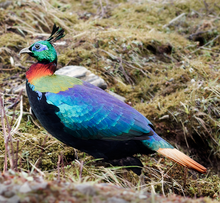 The Himalayan monal (Lophophorus impejanus), also known as the Impeyan monal and Impeyan pheasant, is a pheasant native to Himalayan forests and shrublands at elevations of 2,100-4,500 m (6,900-14,800 ft). It is part of the family Phasianidae and is listed as Least Concern on the IUCN Red List. It is the national bird of Nepal, where it is known as the danphe or danfe, and of Uttarakhand, India, where it is known as the monal. It was also the state bird of Himachal Pradesh until 2007. The Himalayan monal (Lophophorus impejanus), also known as the Impeyan monal and Impeyan pheasant, is a pheasant native to Himalayan forests and shrublands at elevations of 2,100-4,500 m (6,900-14,800 ft). It is part of the family Phasianidae and is listed as Least Concern on the IUCN Red List. It is the national bird of Nepal, where it is known as the danphe or danfe, and of Uttarakhand, India, where it is known as the monal. It was also the state bird of Himachal Pradesh until 2007.
The scientific name commemorates Lady Mary Impey, the wife of the British chief justice of Bengal, Sir Elijah Impey. In some areas, the species is threatened due to poaching and other anthropogenic factors. In the western Himalayas, the local monal population responded negatively to human disturbance involving hydroelectric power development. The male monal was under hunting pressure in Himachal Pradesh, where the crest feather was used to decorate men's hats, until 1982, when hunting was banned in the state. The pheasant is not considered endangered in Pakistan and can be easily located. In some areas, the population density of the species is as high as five pairs per square mile. The main threat to the species is poaching, as the crest is valuable. It is thought to bring status to its wearer and is a symbol of authority.
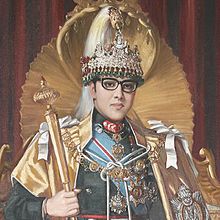 Birendra Bir Bikram Shah (29 December 1944 - 1 June 2001) was the King of Nepal from 1972 until 2001. The eldest son of King Mahendra, he reigned until his death in the 2001 Nepalese royal massacre. Birendra Bir Bikram Shah (29 December 1944 - 1 June 2001) was the King of Nepal from 1972 until 2001. The eldest son of King Mahendra, he reigned until his death in the 2001 Nepalese royal massacre.
Personality From a very young age, Birendra was described by his school teachers as a very kind and emotional prince. King Birendra was described as one of the few Nepalese monarchs who wanted the Nepalese people to experience real democracy. This was observed in the 2036 B.S. Janmat Sangraha (1980 Referendum) when he wanted the people to choose whether they wanted 'Multiparty Democracy' or a 'Reformed Panchayat System'. Also, in People's Movement I, he decided to establish a constitutional monarchy in Nepal instead of fighting for a dictatorship. In 1989, when the People's Movement I was taking momentum, as a condition of safeguarding the Panchayat system, India put forward some conditions to King Birendra aimed at taking control of national sovereignty. If the King had accepted these conditions, the panchayat system would not have ended. But the king said that, "It is better to surrender to the people rather than surrender to India." Some historians have speculated that King Birendra's democratic views and simple nature led to the success of the People's Movement I (1990). He is credited for introducing SAARC in Asia in order to strengthen the foreign relations of Nepal with the other South Asian countries. Early life King Birendra was born at the Narayanhiti Royal Palace in Kathmandu as the eldest son of the then Crown Prince Mahendra Bir Bikram Shah Dev and his first wife, Crown Princess Indra Rajya Lakshmi Devi. Birendra spent eight years studying at St Joseph's School, a Jesuit school in Darjeeling, with his brother Gyanendra. On 13 March 1955 their grandfather King Tribhuvan died and their father succeeded to the Nepalese throne. With his father's ascension King Birendra became the Crown Prince of Nepal. In 1959 King Birendra enrolled at Eton College in the United Kingdom. After studying at Eton until 1964, he returned to Nepal where he began to explore the country by travelling on foot to the remote parts of the country where he lived on whatever was available in the villages and monasteries. He later completed his education by spending some time at the University of Tokyo, before studying political theory at Harvard University from 1967 to 1968. King Birendra enjoyed traveling in his youth and went on trips to Canada, Latin America, Africa, many parts of India and a number of other Asian countries. He was also an art collector and supporter of Nepalese crafts people and artists, and learnt to fly helicopters. King Birendra was married to Aishwarya Rajya Lakshmi Devi from the Rana family, his second cousin, on 27 February 1970. The wedding, which was billed as one of the most lavish Hindu nuptial ceremonies in history, cost $9.5 million to stage. King Birendra and Queen Aishwarya had three children: - Prince Dipendra (27 June 1971 - 4 June 2001).
- Princess Shruti (15 October 1976 - 1 June 2001).
- Prince Nirajan (6 November 1978 - 1 June 2001).
Early reign Birendra succeeded to the Nepalese throne on 31 January 1972, at the age of 27, after the death of his father King Mahendra. On his ascension he was effectively an absolute monarch, as he inherited a country where political parties were banned and he ruled through a system of local and regional councils known as panchayats. Birendra resented the imputation that he was an absolute monarch, maintaining that he presided over a democracy in which representatives to the assembly were indirectly elected and saying that his poor and backward country could not afford a democracy based on party politics and that it needed firm and decisive government. His first trips abroad as king were to India in October 1973 and China two months later as he believed that Nepal, sandwiched between the two Asian powers, should have good relations with both. Coronation in 1975  After his father's (King Mahendra) death in 1972, King Birendra consulted his court astrologers, who advised him to delay his coronation for three years, with the most auspicious moment for his crowning being at 8:37 am precisely on February 4, 1975. Soon after dawn on that day, King Birendra was driven to the temple of his ancestral palace, the Hanuman Dhoka ("gate of the monkey god"). There he was smeared with mud taken from various symbolic places - the bottom of a lake, the tusk of an elephant, a mountain, the confluence of two rivers and the doorstep of a prostitute's house. Then, with Queen Aishwarya beside him, he was cleansed with butter, milk, yogurt and honey as priests chanted praises and salutations. After his father's (King Mahendra) death in 1972, King Birendra consulted his court astrologers, who advised him to delay his coronation for three years, with the most auspicious moment for his crowning being at 8:37 am precisely on February 4, 1975. Soon after dawn on that day, King Birendra was driven to the temple of his ancestral palace, the Hanuman Dhoka ("gate of the monkey god"). There he was smeared with mud taken from various symbolic places - the bottom of a lake, the tusk of an elephant, a mountain, the confluence of two rivers and the doorstep of a prostitute's house. Then, with Queen Aishwarya beside him, he was cleansed with butter, milk, yogurt and honey as priests chanted praises and salutations.
The coronation ceremony was attended by statesmen and political leaders from 60 nations, with the Prince of Wales representing the British Royal Family. The King's personal guests included his former housemaster at Eton, Peter Lawrence, three other masters and 15 old boys. At the ordained time, the chief priest placed on the King's head the emerald green crown, encrusted with jewels and adorned with feathers from a bird of paradise. On the auspicious occasion of his coronation, the King announced that he had ordered his government to make primary education available and free for every child, but disappointed those Nepalis who hoped that he would promise progress towards democracy. Zone of Peace Proposition King Birendra announced of Nepal Zone of Peace proposition during his coronation ceremony reception. He formally asked the international community to endorse his proposal that the United Nations should declare Nepal a ZoP, to give a new dimension to Nepalese stance for non-aligned movement. 1980 referendum In an attempt to maintain the panchayat system of government prominent leaders of the Nepali Congress Party were arrested. Because of the growing pro-democracy movement Birendra announced that a referendum to decide between a non-party and a multi-party system would be held. The referendum was held in May 1980 with the non-party system winning by a margin of 55% to 45%. During the 1980s the restraints that had been imposed on political organisations started to ease, and liberal student-led groups started to demand constitutional change in Nepal. He was appointed as a British Field Marshal in 1980. Democratic era In 1990, a series of strikes and pro-democracy riots broke out in Nepal. Because of the rioting, King Birendra lifted the ban on political parties and agreed to become a constitutional monarch in April, 1990. He appointed an independent Constitution Recommendation Commission to represent the main opposition factions and to prepare a new constitution to accommodate their demands for political reform. The commission presented him with the draft of the proposed constitution on 10 September 1990. The new constitution would make Birendra head of state of a constitutional monarchy with a system of multiparty democracy. The draft constitution was approved by the Prime Minister Krishna Prasad Bhattarai and his cabinet and so, on 9 November 1990, Birendra promulgated the new constitution transforming Nepal into a constitutional monarchy. King Birendra appointed an interim government to pave the way for elections. To head this he chose Krishna Prasad Bhattarai, who he had imprisoned for several years. In a discussion on BBC radio, Krishna Prasad Bhattarai spoke of King Birendra's impeccable personal manners and courtesy and his equally impeccable role as a constitutional monarch. However, the quarrels between various political parties and numerous social problems led to the Nepalese Civil War, a conflict between Maoist rebels and government forces, which lasted from 1996 until 2006. Death
The stability of Nepal was threatened even more when Birendra and his family (including Queen Aishwarya) were massacred at a royal dinner on 1 June 2001. Almost all of the Royal family members were killed in the massacre except Gyanendra Shah, Birendra's younger brother. Dipendra was proclaimed king but died a few days later of self-inflicted gunshot wounds sustained in the massacre. Thus Gyanendra then became king. Eyewitness reports and an official investigation (carried by a two-man committee made up of the Chief Justice of the Supreme Court Keshav Prasad Upadhaya and the Speaker of the House of Representatives Taranath Ranabhat), confirmed that Dipendra was the gunman. Detailed investigation is impossible as the "Tribhuvan Sadan" (the building where the massacre occurred) was demolished by the Gyanendra government which made Gyanendra the most unpopular king.
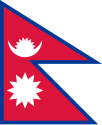 Nepal, officially the Federal Democratic Republic of Nepal is a landlocked country in South Asia. It is located mainly in the Himalayas but also includes parts of the Indo-Gangetic Plain. With an estimated population of 26.4 million, it is 48th largest country by population and 93rd largest country by area. It borders China in the north and India in the south, east, and west while Bangladesh is located within only 27 km (17 mi) of its southeastern tip and Bhutan is separated from it by the Indian state of Sikkim. Nepal has a diverse geography, including fertile plains, subalpine forested hills, and eight of the world's ten tallest mountains, including Mount Everest, the highest point on Earth. Kathmandu is the nation's capital and largest city. Nepal is a multiethnic nation with Nepali as the official language. Nepal, officially the Federal Democratic Republic of Nepal is a landlocked country in South Asia. It is located mainly in the Himalayas but also includes parts of the Indo-Gangetic Plain. With an estimated population of 26.4 million, it is 48th largest country by population and 93rd largest country by area. It borders China in the north and India in the south, east, and west while Bangladesh is located within only 27 km (17 mi) of its southeastern tip and Bhutan is separated from it by the Indian state of Sikkim. Nepal has a diverse geography, including fertile plains, subalpine forested hills, and eight of the world's ten tallest mountains, including Mount Everest, the highest point on Earth. Kathmandu is the nation's capital and largest city. Nepal is a multiethnic nation with Nepali as the official language.
 The name "Nepal" is first recorded in texts from the Vedic Age, the era in which Hinduism was founded, the predominant religion of the country. In the middle of the first millennium BCE, Gautama Buddha, the founder of Buddhism, was born in southern Nepal. Parts of northern Nepal were intertwined with the culture of Tibet. The centrally located Kathmandu Valley was the seat of the prosperous Newar confederacy known as Nepal Mandala. The Himalayan branch of the ancient Silk Road was dominated by the valley's traders. The cosmopolitan region developed distinct traditional art and architecture. By the 18th century, the Gorkha Kingdom achieved the unification of Nepal. The Shah dynasty established the Kingdom of Nepal and later formed an alliance with the British Empire, under its Rana dynasty of premiers. The country was never colonised but served as a buffer state between Imperial China and colonial India. Parliamentary democracy was introduced in 1951, but was twice suspended by Nepalese monarchs, in 1960 and 2005. The Nepalese Civil War in the 1990s and early 2000s resulted in the proclamation of a secular republic in 2008, ending the world's last Hindu monarchy. The name "Nepal" is first recorded in texts from the Vedic Age, the era in which Hinduism was founded, the predominant religion of the country. In the middle of the first millennium BCE, Gautama Buddha, the founder of Buddhism, was born in southern Nepal. Parts of northern Nepal were intertwined with the culture of Tibet. The centrally located Kathmandu Valley was the seat of the prosperous Newar confederacy known as Nepal Mandala. The Himalayan branch of the ancient Silk Road was dominated by the valley's traders. The cosmopolitan region developed distinct traditional art and architecture. By the 18th century, the Gorkha Kingdom achieved the unification of Nepal. The Shah dynasty established the Kingdom of Nepal and later formed an alliance with the British Empire, under its Rana dynasty of premiers. The country was never colonised but served as a buffer state between Imperial China and colonial India. Parliamentary democracy was introduced in 1951, but was twice suspended by Nepalese monarchs, in 1960 and 2005. The Nepalese Civil War in the 1990s and early 2000s resulted in the proclamation of a secular republic in 2008, ending the world's last Hindu monarchy.
.svg/220px-Nepal_(orthographic_projection).svg.png) The Constitution of Nepal, adopted in 2015, establishes Nepal as a federal secular parliamentary republic divided into seven provinces. Nepal was admitted to the United Nations in 1955, and friendship treaties were signed with India in 1950 and the People's Republic of China in 1960. Nepal hosts the permanent secretariat of the South Asian Association for Regional Cooperation (SAARC), of which it is a founding member. Nepal is also a member of the Non Aligned Movement and the Bay of Bengal Initiative. The military of Nepal is the fifth largest in South Asia; it is notable for its Gurkha history, particularly during the world wars, and has been a significant contributor to United Nations peacekeeping operations. The Constitution of Nepal, adopted in 2015, establishes Nepal as a federal secular parliamentary republic divided into seven provinces. Nepal was admitted to the United Nations in 1955, and friendship treaties were signed with India in 1950 and the People's Republic of China in 1960. Nepal hosts the permanent secretariat of the South Asian Association for Regional Cooperation (SAARC), of which it is a founding member. Nepal is also a member of the Non Aligned Movement and the Bay of Bengal Initiative. The military of Nepal is the fifth largest in South Asia; it is notable for its Gurkha history, particularly during the world wars, and has been a significant contributor to United Nations peacekeeping operations.
| 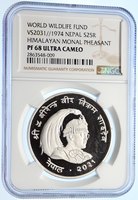
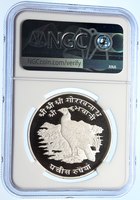
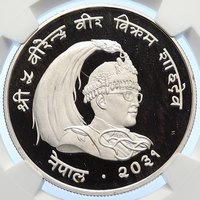
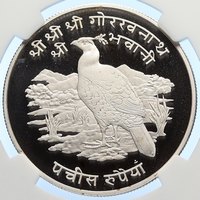
 The Himalayan monal (Lophophorus impejanus), also known as the Impeyan monal and Impeyan pheasant, is a pheasant native to Himalayan forests and shrublands at elevations of 2,100-4,500 m (6,900-14,800 ft). It is part of the family Phasianidae and is listed as Least Concern on the IUCN Red List. It is the national bird of Nepal, where it is known as the danphe or danfe, and of Uttarakhand, India, where it is known as the monal. It was also the state bird of Himachal Pradesh until 2007.
The Himalayan monal (Lophophorus impejanus), also known as the Impeyan monal and Impeyan pheasant, is a pheasant native to Himalayan forests and shrublands at elevations of 2,100-4,500 m (6,900-14,800 ft). It is part of the family Phasianidae and is listed as Least Concern on the IUCN Red List. It is the national bird of Nepal, where it is known as the danphe or danfe, and of Uttarakhand, India, where it is known as the monal. It was also the state bird of Himachal Pradesh until 2007.  Birendra Bir Bikram Shah (29 December 1944 - 1 June 2001) was the King of Nepal from 1972 until 2001. The eldest son of King Mahendra, he reigned until his death in the 2001 Nepalese royal massacre.
Birendra Bir Bikram Shah (29 December 1944 - 1 June 2001) was the King of Nepal from 1972 until 2001. The eldest son of King Mahendra, he reigned until his death in the 2001 Nepalese royal massacre.  After his father's (King Mahendra) death in 1972, King Birendra consulted his court astrologers, who advised him to delay his coronation for three years, with the most auspicious moment for his crowning being at 8:37 am precisely on February 4, 1975. Soon after dawn on that day, King Birendra was driven to the temple of his ancestral palace, the Hanuman Dhoka ("gate of the monkey god"). There he was smeared with mud taken from various symbolic places - the bottom of a lake, the tusk of an elephant, a mountain, the confluence of two rivers and the doorstep of a prostitute's house. Then, with Queen Aishwarya beside him, he was cleansed with butter, milk, yogurt and honey as priests chanted praises and salutations.
After his father's (King Mahendra) death in 1972, King Birendra consulted his court astrologers, who advised him to delay his coronation for three years, with the most auspicious moment for his crowning being at 8:37 am precisely on February 4, 1975. Soon after dawn on that day, King Birendra was driven to the temple of his ancestral palace, the Hanuman Dhoka ("gate of the monkey god"). There he was smeared with mud taken from various symbolic places - the bottom of a lake, the tusk of an elephant, a mountain, the confluence of two rivers and the doorstep of a prostitute's house. Then, with Queen Aishwarya beside him, he was cleansed with butter, milk, yogurt and honey as priests chanted praises and salutations.  Nepal, officially the Federal Democratic Republic of Nepal is a landlocked country in South Asia. It is located mainly in the Himalayas but also includes parts of the Indo-Gangetic Plain. With an estimated population of 26.4 million, it is 48th largest country by population and 93rd largest country by area. It borders China in the north and India in the south, east, and west while Bangladesh is located within only 27 km (17 mi) of its southeastern tip and Bhutan is separated from it by the Indian state of Sikkim. Nepal has a diverse geography, including fertile plains, subalpine forested hills, and eight of the world's ten tallest mountains, including Mount Everest, the highest point on Earth. Kathmandu is the nation's capital and largest city. Nepal is a multiethnic nation with Nepali as the official language.
Nepal, officially the Federal Democratic Republic of Nepal is a landlocked country in South Asia. It is located mainly in the Himalayas but also includes parts of the Indo-Gangetic Plain. With an estimated population of 26.4 million, it is 48th largest country by population and 93rd largest country by area. It borders China in the north and India in the south, east, and west while Bangladesh is located within only 27 km (17 mi) of its southeastern tip and Bhutan is separated from it by the Indian state of Sikkim. Nepal has a diverse geography, including fertile plains, subalpine forested hills, and eight of the world's ten tallest mountains, including Mount Everest, the highest point on Earth. Kathmandu is the nation's capital and largest city. Nepal is a multiethnic nation with Nepali as the official language.  The name "Nepal" is first recorded in texts from the Vedic Age, the era in which Hinduism was founded, the predominant religion of the country. In the middle of the first millennium BCE, Gautama Buddha, the founder of Buddhism, was born in southern Nepal. Parts of northern Nepal were intertwined with the culture of Tibet. The centrally located Kathmandu Valley was the seat of the prosperous Newar confederacy known as Nepal Mandala. The Himalayan branch of the ancient Silk Road was dominated by the valley's traders. The cosmopolitan region developed distinct traditional art and architecture. By the 18th century, the Gorkha Kingdom achieved the unification of Nepal. The Shah dynasty established the Kingdom of Nepal and later formed an alliance with the British Empire, under its Rana dynasty of premiers. The country was never colonised but served as a buffer state between Imperial China and colonial India. Parliamentary democracy was introduced in 1951, but was twice suspended by Nepalese monarchs, in 1960 and 2005. The Nepalese Civil War in the 1990s and early 2000s resulted in the proclamation of a secular republic in 2008, ending the world's last Hindu monarchy.
The name "Nepal" is first recorded in texts from the Vedic Age, the era in which Hinduism was founded, the predominant religion of the country. In the middle of the first millennium BCE, Gautama Buddha, the founder of Buddhism, was born in southern Nepal. Parts of northern Nepal were intertwined with the culture of Tibet. The centrally located Kathmandu Valley was the seat of the prosperous Newar confederacy known as Nepal Mandala. The Himalayan branch of the ancient Silk Road was dominated by the valley's traders. The cosmopolitan region developed distinct traditional art and architecture. By the 18th century, the Gorkha Kingdom achieved the unification of Nepal. The Shah dynasty established the Kingdom of Nepal and later formed an alliance with the British Empire, under its Rana dynasty of premiers. The country was never colonised but served as a buffer state between Imperial China and colonial India. Parliamentary democracy was introduced in 1951, but was twice suspended by Nepalese monarchs, in 1960 and 2005. The Nepalese Civil War in the 1990s and early 2000s resulted in the proclamation of a secular republic in 2008, ending the world's last Hindu monarchy. .svg/220px-Nepal_(orthographic_projection).svg.png) The Constitution of Nepal, adopted in 2015, establishes Nepal as a federal secular parliamentary republic divided into seven provinces. Nepal was admitted to the United Nations in 1955, and friendship treaties were signed with India in 1950 and the People's Republic of China in 1960. Nepal hosts the permanent secretariat of the South Asian Association for Regional Cooperation (SAARC), of which it is a founding member. Nepal is also a member of the Non Aligned Movement and the Bay of Bengal Initiative. The military of Nepal is the fifth largest in South Asia; it is notable for its Gurkha history, particularly during the world wars, and has been a significant contributor to United Nations peacekeeping operations.
The Constitution of Nepal, adopted in 2015, establishes Nepal as a federal secular parliamentary republic divided into seven provinces. Nepal was admitted to the United Nations in 1955, and friendship treaties were signed with India in 1950 and the People's Republic of China in 1960. Nepal hosts the permanent secretariat of the South Asian Association for Regional Cooperation (SAARC), of which it is a founding member. Nepal is also a member of the Non Aligned Movement and the Bay of Bengal Initiative. The military of Nepal is the fifth largest in South Asia; it is notable for its Gurkha history, particularly during the world wars, and has been a significant contributor to United Nations peacekeeping operations. 
